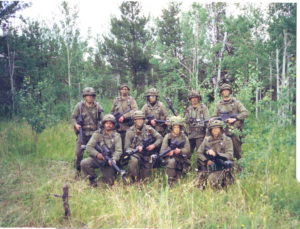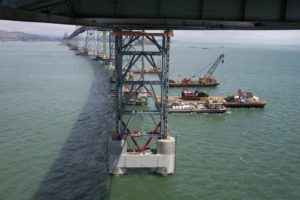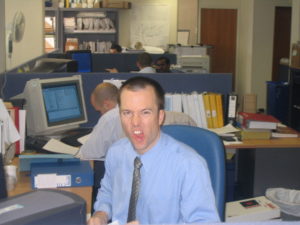When I was 12, I decided that I was going to be an air cadet. I don’t recall exactly how I heard about cadets, but I knew I wanted to try it out. So, one Thursday evening I walked up the hill from my house to the school where the local air cadets paraded, and signed myself up. I spent 4 years as an air cadet progressing through the ranks to Flight Sergeant, and attending camps three summers in a row. I must have known early on that I was going to join the Air Force and become a fighter pilot, because after spending 2 weeks my first summer at an air crew survival course in Cold Lake Alberta, I focused on leadership camps instead of flying training (in air cadets, you can get glider pilot wings and basic flight training). I first attended a 3 week Junior Leadership Course in Penhold, Alberta, and the following summer attended the pinnacle of Air Cadet non-flying courses, the six week Senior Leadership Course in Cold Lake.
My air cadet career was cut short by a family move from Nelson to Prince Rupert so my dad could get a good job, and I transferred to the Sea Cadets. This was one of my first challenging leadership and cultural adaptation experiences. I parachuted into the local Sea Cadet Corps with the highest rank in the unit, and none of the Navy cultural norms or traditions integrated with how I presented myself. Needless to say, the day I was put in charge of the Corps led to some challenging interactions with the established pecking order. My dad’s advice was to conduct myself with a sense of humour. I added to this following the Canadian Forces 10 principals of leadership, and things didn’t completely disintegrate!
Air Cadets, staying at Cold Lake two summers (where half of Canada’s jet fighters are stationed), and the movie Top Gun planted some very virile seeds in my young head. By the time I was 17 I was determined I was going to be a fighter pilot. Then again, so were about half of the people I signed up with! Again, I don’t really remember how exactly I processed the decisions I made back then, but the end result was that at the completion of Grade 11, I had the first half of the summer off, and then in August of 1991, I flew to Montreal Quebec to start my career as a regular force officer cadet at College Militaire Royale de St. Jean (CMR).
The whole fighter pilot thing didn’t even last the first year of Military College. By the time I went to Toronto to go through the air crew selection process during spring break, my eyesight had gone from”just good enough” to “just not good enough” to be a pilot. My fate was sealed – I would become an air navigator. That summer (1992) I attended the Basic Officer Training Course in Chilliwack, BC. We spent considerable time in the field doing army-ish small party taskings. I liked it. I went on to join the Combat Arms Club at CMR so I could get more running around in the woods time. Some new seeds were beginning to take root in my young and impressionable mind.
I don’t recall exactly, but I think that I began to ask for a voluntary occupational transfer to the combat engineer trade (or any engineer trade) during 1st Year at CMR (which was my second year there, but the first year, which was a grade 12 equivalency, was called Preparatory Year). Why did I want out of the Air Navigator trade? I was studying engineering, which was really hard, and I made the reasonable deduction that if I couldn’t be a fighter pilot, I could at least get into a trade where all the hard work becoming an engineer wouldn’t go to waste. I asked again every year after that until finally, in fourth year, I was granted the transfer to Army Engineering Officer (along with at least 4 other former pilot hopefuls who ended up as air navigators).
As I had spent my summers during military college doing the air force training that gets assigned to navigators (all of which made me want to transfer even more), my army engineer training got compressed into a year and a half following graduation and commissioning. It started with the section commander course, or Phase 2, the first summer (which I almost failed), followed by most of the last course, Phase 4 (tactics and some general training), which was followed by one of the oddest and exciting three month stints of my entire career. At the completion of phase 4 in March of 1997, there was a gap in my training until I could complete phase 3 (out of order) starting in May of 1997. The Engineer Corps decided that the 4 or 5 of us in this boat would be attached posted to our eventual units, and go and do some OJT to fill the time. I ended up in Edmonton to join 1 Combat Engineer Regiment (1 CER). We were immediately taken to Wainwright to join the Regiment on a winter exercise, and thrown into the unit as section members. I believe that the commanding officer at the time, LCol Steve Appleton, wanted to give us the chance to prove to the troops that we were competent soldiers, before we were put in charge of some of them. After this ex, where I got to blow up lots of stuff, we returned to Edmonton, spent some time settling into our first jobs (I was made the Regimental Intelligence Officer (Int O)), and then three of us got the chance to see if we could go on the Basic Parachutist Course. We all got to go! While we were in Trenton getting our jump wings, the whole Canadian Army deployed to Winnipeg for the “Flood of the Century”. Everyone on the jump course flew direct from Trenton to join our respective units. My first operation! Following that deployment, it was back to Edmonton for a couple of weeks, and then onto the final courses I needed to become fully qualified as a combat engineer officer.
In all, I spent a little over two years at 1 CER. I served first as the Int O, and in addition to the deployment to Winnipeg I got to deploy to St Jean Quebec when most of eastern North America was plunged into darkness by a massive ice storm in the winter of 1998. I then became the Heavy Equipment Troop Commander, which was a great job. I had 20 or so sappers and 30 or so pieces of equipment and trucks to lead, with the basic role of providing heavy equipment support to 1 Canadian Mechanized Brigade Group. However, things weren’t supposed to go that way…
Another thing happened in 1997 – I met my first wife. She moved to Edmonton with me in 1998 or so, and started going to the University of Alberta. She didn’t like the army life one bit, and constantly complained about it and pressured me to make her (and ostensibly our marriage) a priority. So I did.
The first thing I did was write my chain of command a memo indicating that at the end of my obligatory service, I would be getting out. The immediate result of this was my becoming the Heavy Equipment Troop Commander, instead being given the much coveted 4 Troop, the “jump” troop. The second thing I did was actively resist and complain about an attached posting to Wainwright to be a course officer for a Junior Leadership / Junior NCO Course (as my first wife didn’t want me away for 4 months). Needless to say, I wasn’t the most popular junior officer with my chain of command. Finally, the crowning achievement of this train wreck of career destruction was doing everything possible to fight a posting to Suffield, Alberta (including writing directly to the Chief of Defence Staff). All in all, career suicide was complete. My CO at the time, LCol Paul Wynnyk, tore a strip off me about the whole thing one day near the end of my time there. It was well deserved. Fittingly, he is now the commander of the Canadian Army.
I went to Suffield regardless of my efforts to stay in Edmonton. My first wife stayed in the house we had bought together and continued her university. I would drive home almost every weekend, leaving early Monday morning to get the 5 hour drive done before work started at 8 am. It was exhausting, and the quality of my marriage continued to deteriorate. In 2001 I was posted back to Edmonton to be the Planning Officer at the base engineering section. However, with career suicide completed, and my first wife wanting anything for our lives but the Army, I released in 2002 on my 28th birthday. The following Monday, I was starting my new career as an engineering consultant in Oakland, California.
Following the premature end to my Army career, we bounced around the world – literally. A year and a half in California, 8 months in Ireland, 2 months travelling via India, Thailand, Australia and New Zealand. Married on paper but not a team – not united. We arrived back in Canada pregnant, jobless, homeless, and car-less. Looking back now, but for the pregnant part, I was fed up enough with things that I probably would have left. Even with the pregnant part, there was at least one time when I almost left anyways, after our return to Canada. However, being principled and committed, I stuck it out for another 6 years as we had our son, I started my current job, and we moved to Courtenay, BC on Vancouver Island. Despite professional success, I don’t think I could have been more unhappy.
Finally, in 2008 it all fell apart. Again, to stick to my commitment to my now defunct marriage, I sacrificed myself, fiscally this time, and basically had to start my life over. I made a disastrously large settlement agreement with my now separated spouse, and, as she claimed she couldn’t work, was forking over a large chunk of my salary in child support payments (despite the fact that I have 50% custody). It took me almost 6 years to dig out from the financial, social, emotional and psychological damage staying in an abusive relationship caused me. At one point in my recovery it even dawned on me that I had a mild case of PTSD as a result.
As I moved through this recovery, and started to reclaim myself, I found I had desire, and the time, to serve my community. I pursued this passion through various avenues including co-founding Imagine Comox Valley, using that organization to do the first Car Free Sunday on Vancouver Island and to bring TEDxComoxValley to life. I joined the Chamber of Commerce board, and became the Chair. I even volunteered at local music festivals and worked my way up from stage hand to production manager. I started playing music again, and was in two local bands, achieving some bar scene success and earning a little bit of money to play music. I had time to go skiing, and took up back country skiing, even being on the board of directors at Mt Cain. Through it all though, I felt something lacking.
In 2014, after 6 years of digging myself out of the hole I had made, I had an epiphany. I wasn’t done being an Army officer, so I set out to become one again.
It took almost two years of working through the bureaucracy of the CF recruiting system, but eventually I made it happen. While circumstances dictate that I can’t be a full time regular force officer, I am now serving as an officer in the Primary Reserve. Due to the fortunate happenstance of staying on the supplemental reserve list until 2006, the majority of my qualifications were not deemed “past due”, and I was able to re-enroll at rank in my trade of Combat Engineer. On April 7, 2016, I was sworn in as a member of the Canadian Armed Forces for the second time in my life. I felt a certain satisfaction from achieving the goal of getting back in, but was honestly wondering if it was the right choice.
I went on my first exercise at the end of April (2016), and was tasked to be the Squadron second-in-command. Assuming that role felt like slipping on an old, comfortable pair of boots. It was the final validation that I had made the correct decision in putting on a uniform again. I’m a Captain again, and loving it.
This Sunday, right at the end of Atmosphere Gathering (an event I helped create), I returned from 12 days of Army training at Wainwright, Alberta, where I worked in the Joint Operations Centre for Ex Cougar Conqueror 2016. While the experience was challenging, I did not find it overly stressful – I felt pressure and a time crunch, sure – but not anxiety. I felt at home.
I am a warrior. I am not, by nature, violent, but I believe in our society enough that I spent a good part of my life living with the knowledge that I had accepted unlimited liability – i.e. I was wiling to die for the idea that is Canada. I feel at home in uniform with warriors around me. This is just a big part of who I am.
I am a citizen soldier. My day to day life is that of a father, partner, and professional engineer. However, I also dedicate a portion of my life to soldiering. To training and leading others who live as citizen soldiers – who have a desire to serve their country as warriors.
I wouldn’t trade the life I have lived, as it has helped to make me who I am today. I live in a great town, have an amazing partner, a rewarding career, and a beautiful home.
Now, with the Army back in my life, I feel whole.





Wow. Courage. Welcome back, Citizen Class!
Well that was interesting Buddy.. To tell the truth I always thought their was an interesting contrast in the Andrew that will dance at atmosphere, work for car free+ green spaces etc. and also be a soldier. I love it when people make things happen because they’ve decided to make then happen.
Well written! Glad you found your true path in life.
“I wouldn’t trade the life I have lived, as it has helped to make me who I am today. I live in a great town, have an amazing partner, a rewarding career, and a beautiful home.”
You forgot someone?!?
Love Auntie Kathy